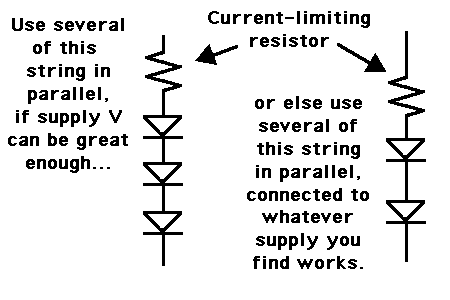grizedale
Advanced Member level 3
Hello, we are putting Cree XPEWHT (white) LEDs three-in-parallel, and wish to match the currents to within +/-20%
The total current through each LED would be 425mA if perfectly matched.
However, the information that we need to match the LEDs is in the form of I-V curves which are simply not provided in the XPEWHT datasheet.
The graph we need is as in Figure 3, Page 2 of the following application note................
Figure 3, Page 2
**broken link removed**
LED datasheet
XPEWHT LEDs
**broken link removed**
..this datasheet clearly does not provide anything like figure 3 , page 2 of the app note....Page 8 of the datasheet shows an i-v curve for the white led, but its just one curve, and thats not enough for us.
-So how are we supposed to mathc up the LED currents.
The LEDs are driven by a buck led driver as follows....( the total average current from the buck's output diode is 2.55 Amps)

(the idea is to use the absolute minimum resistor value which gives us the +/-20% variance, so that we keep efficiency as high as possible)
The total current through each LED would be 425mA if perfectly matched.
However, the information that we need to match the LEDs is in the form of I-V curves which are simply not provided in the XPEWHT datasheet.
The graph we need is as in Figure 3, Page 2 of the following application note................
Figure 3, Page 2
**broken link removed**
LED datasheet
XPEWHT LEDs
**broken link removed**
..this datasheet clearly does not provide anything like figure 3 , page 2 of the app note....Page 8 of the datasheet shows an i-v curve for the white led, but its just one curve, and thats not enough for us.
-So how are we supposed to mathc up the LED currents.
The LEDs are driven by a buck led driver as follows....( the total average current from the buck's output diode is 2.55 Amps)

(the idea is to use the absolute minimum resistor value which gives us the +/-20% variance, so that we keep efficiency as high as possible)
